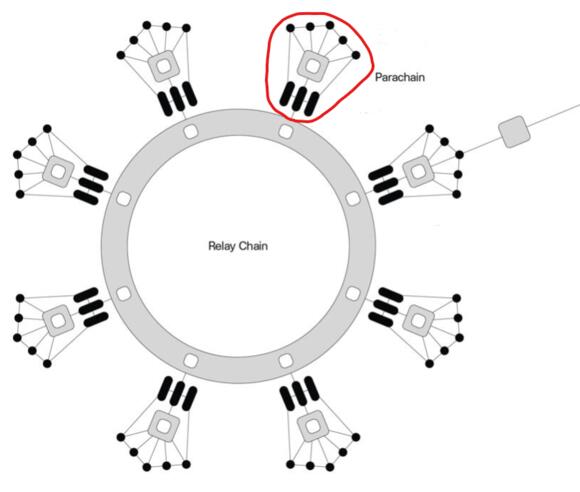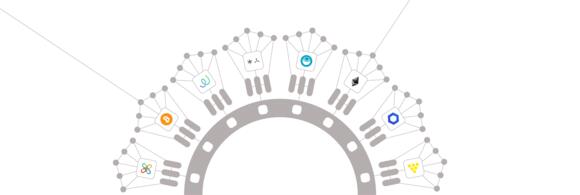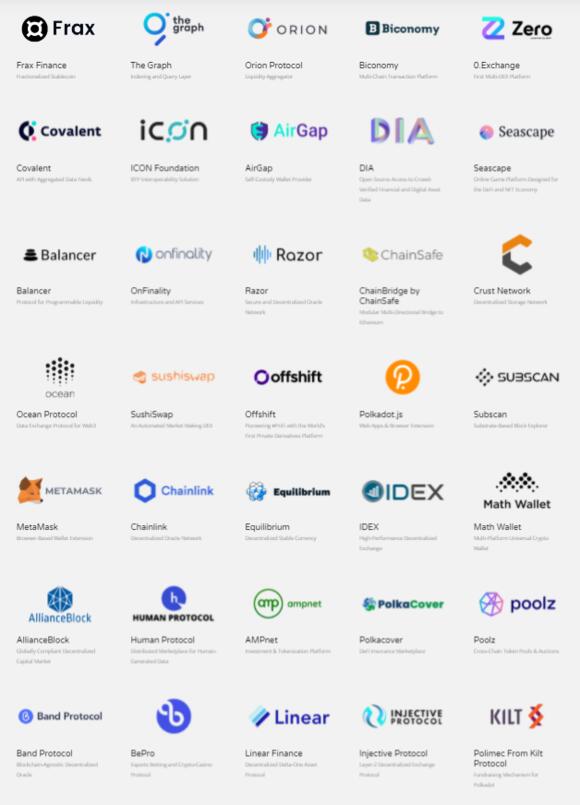If you know anything about Polkadot (DOT) then you know that there is a lot of hype surrounding Parachain auctions. Both Polkadot and its wild cousin Kusama (KSM) have a characteristic architecture of their blockchain in which they have a core, the Relay Chain, surrounded by various Parachains. Parachains are individual blockchains that can have their own tokens and optimize their functionality for specific use cases.
However, Polkadot is a young project that only launched in May 2020. Parachains are an important part of the project, but are not yet part of the ecosystem. We also know that only a limited number of Parachain spots will be available and that the competition for such a spot will be fierce.
One of the crypto projects competing for a Parachain spot is Moonbeam. Moonbeam wants to become the bridge between the smart contracts compatibility of Ethereum and the scalability and interoperability of Polkadot.
Not to worry, in this article we take a deep dive into Moonbeam and cover exactly what they want and answer the question: what is Moonbeam (GLMR)?
Quick view:
- Quick view:
- Parachain spot on Polkadot
- What is Moonbeam?
- Web 3.0: a multi-chain future
- Who is Moonbeam made for?
- Kusama
- moon river
- Moonbeam Ecosystem Tokens
- Tokenomics
- Partnerships
- roadmap
- Conclusion
Parachain spot on Polkadot
Before analyzing Moonbeam as a crypto project, it is wise to understand what exactly a Parachain spot is.
Bitcoin (BTC) is best known for its decentralized properties, which makes it a good store-of-value, in other words: a store of value. Ethereum (ETH) takes a completely different tack in that respect. Ethereum is the underlying network of an entire ecosystem that is built on it. This ecosystem includes, for example, DeFi and NFTs.
Polkadot tries to build an ecosystem similar to Ethereum, but does it slightly differently. Polkadot also focuses on the interoperability of different networks. Interoperability means the problem-free collaboration of different blockchains.
Thus, the main differentiating feature of Polkadot is cross-chain interoperability. With this interoperability, Polkadot wants to set up a completely decentralized and private network, which is controlled by the users.
Polkadot wants to use this network to make it easier to create new applications and services. The network protocol does this by connecting both public and private blockchains, oracles and future technologies through the Relay Chain. The independent blockchains are called “Parachains”.
If you want to know more about how Polkadot works exactly and what all the different parts of the network are, read the detailed explanation of Polkadot here.
Below is an image to give you a better idea of the architecture of the Polkadot ecosystem.
IMG 
Broadly speaking, the Polkadot ecosystem consists of two parts: the Relay Chain and around it the Parachains. Incidentally, Kusama has the same architecture.
- Relay Chain is the most important part and core of Polkadot’s architecture. All the different blockchains that are connected as a parachain to the Polkadot network are connected to each other via the Relay Chain.
- Parachains are individual blockchains that can have their own tokens and optimize their functionality for specific use cases. Only a limited number of spots will be available, currently estimated at 100 spots .
Because the number of slots is limited, Polkadot uses Parachain slot auctions. Parachain auctions are literally auctions. Parachain bidders can bid in the auction by specifying the spot on the Relay Chain they want, as well as the number of DOT Tokens they are willing to spend.
One of the most promising Parachain bidders is Moonbeam, but it is still uncertain when the Parachain auctions will take place on Polkadot.
Do you want to know more about Polkadot (DOT)? In the video below from AllesOverCrypto, Matt explains everything about Polkadot!
What is Moonbeam?
Moonbeam is thus a project competing for a Parachain spot. As you now know, every Parachain can have its own functionality and that is certainly the case with Moonbeam. Moonbeam wants to become the user-friendly bridge between Ethereum and Polkadot for developers.
Moonbeam is a smart contract platform that provides an Ethereum-combinable environment for building dApps .
Web 3.0: a multi-chain future
Like Polkadot, Moonbeam believes in a future where multiple blockchains work together seamlessly. This is also known as multi-chain interoperability. The vision of the team behind Moonbeam is therefore:
We believe in a multi-chain future with many chains, and many users and assets on those chains.
Based on this vision, the team then started working on Moonbeam.
Moonbeam is designed to serve the new types of assets and users that will be used on multiple blockchains. Moonbeam is really looking at the future of the internet: Web 3.0.
Web 3.0 is the upcoming third generation of the internet where websites and (d)apps will be able to process information in a smart, decentralized way.
Existing smart contract platforms, such as Ethereum and Cardano (ADA), are designed for that specific blockchain. By providing cross-chain smart contract functionality, Moonbeam enables developers to move existing smart contracts to Moonbeam. With this, Moonbeam extends the reach of the dApps by extending them to new users on other blockchains.
So you can really think of Moonbeam as a developer-friendly bridge between Ethereum and Polkadot. And because Polkadot is focused on interoperability, Moonbeam connects the dApps here with every other blockchain that is connected to Polkadot via a Polkadot Bridge.
That’s right, in addition to the Parachains and the Relay Chain, the Polkadot ecosystem also consists of bridges. Bridges , or blockchain bridges, are ways in which two self-contained and technologically different blockchains can communicate with each other.
The image below shows what such a bridge looks like. The Parachains are therefore not blockchains built on Substrate, Polkadot’s blockchain framework, but are their own, independent blockchains, such as the Bitcoin blockchain and the Chainlink blockchain.
IMG 
Who is Moonbeam made for?
There are three main audiences that can benefit most from Moonbeam’s cross-chain functionality:
Existing Ethereum-Based Projects
Ethereum is under fire because of the network’s high transaction costs and long transaction time. Crypto projects on Ethereum are struggling with scalability challenges and can use Moonbeam to:
- Move parts of their existing workload off the Ethereum main-chain without changing much.
- Expanding the reach to the Polkadot ecosystem and other blockchains connected to Polkadot.
- Deploy a multi-chain where dApps run simultaneously on both Ethereum and Moonbeam.
Polkadot Ecosystem Projects
Besides Moonbeam, there are many more crypto projects that see the benefit of Polkadot. Read an article about promising Polkadot projects here. These Polkadot projects that require smart contract functionality can use Moonbeam to:
- Add new functionality that is needed but not included in the Relay Chain. For example, with Moonbeam they could create a platform with which they can crowdfund their project.
- Using the comprehensive Ethereum development toolkit.
Developers of new DApps
Individuals and teams that are not building yet, but want to try building on Polkadot, can also use Moonbeam to:
- Leveraging the specialized functionality of Polkadot parachains, such as reaching other blockchains via Bridges.
Kusama
As you know by now, there are no parachain auctions on Polkadot yet. Kusama, the wild cousin of Polkadot, got its nickname because everything within the Kusama ecosystem can be implemented faster and with less control. And so the Parachain auctions were recently announced:
IMG 
The tweet reproduced above describes that an upgrade proposal has just passed “Council” and is now a public referendum. Now I hear you thinking: “Huh, since when is crypto so political?”
The Polkadot ecosystem and therefore also the Kusama ecosystem have a governance model. The board is about the future of a crypto: any upgrades and adjustments to the network. Such a governance model consists of various governing bodies, such as the Board and the Technical Committee. If you want to know exactly how the governance model works, read the detailed explanation about the governance model of Polkadot and Kusama here.
moon river
Anyways: Parachains are therefore more likely to be on Kusama than on Polkadot. For that reason, Moonbeam has chosen to also claim a Parachain spot in the Kusama ecosystem. However, this will not go on the same name, but on the name Moonriver .
Moonriver’s deployment to Kusama is scheduled for Q2 2021. Moonbeam itself is scheduled for Q3 2021.
Moonriver is intended to be a companion network to Moonbeam, where it will become a permanently stimulated canary network.
The name canary network comes from the idea of canaries used in coal mines to warn miners by detecting carbon monoxide and other poisonous gases that could injure them. The canaries died much earlier, so the miners knew that there were poisonous gases in the air.
Similarly, Moonriver works like a canary, alerting and helping to spot vulnerabilities or weaknesses in Moonbeam’s code base.
New code will first be sent to Moonriver where it can be tested and verified under real economic conditions. Once proven, the same code will be sent to Moonbeam on Polkadot.
It is important to know that Moonriver is its own independent project. Moonriver also has its own token: the RIVER token, which we will talk about in a moment.
Moonbeam Ecosystem Tokens
As decentralized smart contract platforms, Moonbeam and Moonriver require their own utility tokens, Glimmer (GLMR) and River (RIVER), to function properly. The GLMR token for Moonbeam, and RIVER token for Moonriver.
Without these tokens, network participants cannot access the functions of both networks. Both tokens have the same uses, only for their own network. The applications are:
- Pay transaction fees to access and support network operations.
- Motivation of the collators. The collators are the entire nodes responsible for maintaining Parachains on Polkadot and Kusama.
- Support Ethereum’s ‘gas’ metering through the execution of smart contracts.
- Supporting governance mechanisms on the blockchain by, for example, proposing referenda, voting and electing councillors.
- Powering the engineering needed to create the decentralized node infrastructure on which both networks operate.
Tokenomics
By tokenomics we understand the economic setting and economic policy of the distribution, production and distribution of a project’s tokens. This is an increasingly important aspect of a good project, as an unfair distribution of tokens is often bad for a crypto’s reputation and decentralized nature.
Glimmer (GLMR)
On the day of the launch of the Moonbeam network, the total supply will be 10 million Glimmer tokens.
A portion of the network tokens is reserved to ensure that the network secures and maintains a parachain spot on the Polkadot network. So Moonbeam uses this as capital for the parachain auctions.
A significant portion of the network (16%) is also reserved for a future public sale, which will take place shortly before the network’s public launch. The quantity for sale can be increased based on the public demand. Details about its sale are not yet known.
Moonbeam aims for an annual inflation rate of 5% and as such has an unlimited token supply. The purpose of inflation in Moonbeam is to pay for the network’s ongoing security needs.
IMG 
River (RIVER)
The overall offerings and token applications on Moonriver will be the same as on Moonbeam, but the distribution of tokens will be different to support the network’s unique goals and features.
Moonriver will serve as a canary network for Moonbeam, but it will also be a community-led experiment where the community will decide which direction the project will take. As a result, the distribution of the tokens is significantly different from the GLMR tokens. Among other things, Moonriver will use a large parachain crowd loan to obtain its first parachain slot on Kusama.
A majority of tokens (60%) will be distributed fairly and without permission as part of the initial auction.
Moonriver aims for an annual inflation rate of 5% and therefore has an unlimited supply of tokens. The purpose of inflation in Moonriver is to pay for the network’s ongoing security needs.
IMG 
Partnerships
Moonbeam is just about the most hyped Parachain project out there. A visit to Moonbeam’s partnerships page shows the same. Large projects such as Chainlink (LINK), DIA (DIA), Orion Protocol (ORN), Ocean Protocol (OCEAN), Polkastarter (POLS) and MetaMask are in full swing on Moonbeam.
IMG 
roadmap
Moonbeam is still being actively developed and there is no clear roadmap yet. This is also largely due to the dependence on when parachain auctions are announced on the Polkadot network.
The rough roadmap is to launch Moonriver, the Kusama implementation, by the end of Q2 2021, and Moonbeam on the Polkadot MainNet in Q3 2021.
Conclusion
Moonbeam is a developer-oriented blockchain that aims to be compatible with the existing Ethereum network and its developer toolset.
The main features of Moonbeam that should ensure this are:
- A full Ethereum Virtual Machine implementation; allowing Solidity (Ethereum programming language) based smart contracts to be migrated with minimal changes and with the same expected execution results.
- Implementation of the Web3 RPC API ; so that existing dApp front-ends (user interface) can be migrated with minimal change, and so that existing Ethereum-based tools, such as MetaMask, can be used without change against Moonbeam.
- Compatible with the Substrate Ecosystem Toolset; including block explorers, front-end development libraries, and wallets, so developers and users can use the right tool for what they’re trying to accomplish.
- Native Cross-Chain Integration via the Polkadot network and via token bridges, enabling token movement and message forwarding with Ethereum and other blockchains, such as Binance Smart Chain and Cardano.
- On-Chain Governance; to enable stakeholders and network participants to evolve the base protocol quickly and without forking according to the needs of developers and the community.
All in all, Moonbeam really brings something unique to the market. Polkadot, like Cardano, is often told that no actual developments are happening yet, as is the case with Ethereum.
Moonbeam actually fills this gap by not competing with Ethereum, but by becoming a bridge between Ethereum developers and all other blockchains connected through Polkadot.
For many developers and projects, an Ethereum-compatible smart contract approach will be much easier and faster to implement than creating their own new blockchain on Substrate, Polkadot’s programming kit.
By building these smart contracts on Moonbeam, developers can still integrate with other chains and get value from Polkadot-based network effects.
Finally, creating your own canary network on Kusama is also a good strategic move in my opinion. This allows Moonbeam to run tests and build a community before launching “for real” on Polkadot.
There are quite a few complicated and technical topics covered in this article. Hopefully it’s explained clearly and simply enough for you to understand. If you still have questions, we would like to invite you to throw a ball in our AllesOverCrypto Facebook group. There, AOC’ers and members of the group are always willing to answer your questions. See you there then!



